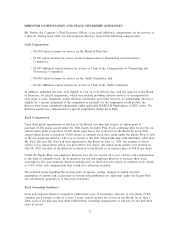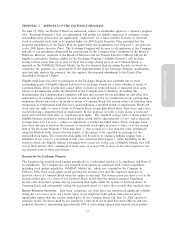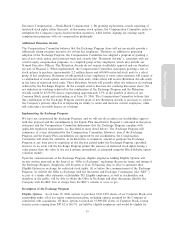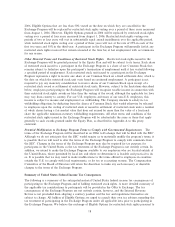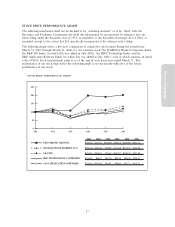Electronic Arts 2006 Annual Report Download - page 33
Download and view the complete annual report
Please find page 33 of the 2006 Electronic Arts annual report below. You can navigate through the pages in the report by either clicking on the pages listed below, or by using the keyword search tool below to find specific information within the annual report.
PROPOSAL 3. AMENDMENTS TO THE 2000 EQUITY INCENTIVE PLAN
The 2000 Equity Incentive Plan, which initially was approved by the stockholders on March 22, 2000,
continues EA's program of providing equity incentives to eligible employees, oÇcers and directors. We
oÅer these incentives in order to assist in recruiting, retaining and motivating qualiÑed employees, oÇcers
and directors. Since the Equity Plan's adoption, 67,400,000 shares of common stock have been reserved for
issuance. The following summary of the proposed amendments to the Equity Plan is subject to the speciÑc
provisions contained in the full text of the Equity Plan, as proposed to be amended, which we have Ñled
with the Securities and Exchange Commission along with this proxy statement. For more information
regarding the Equity Plan, we urge you to read the full text of the Equity Plan, as proposed to be
amended, or the summary of its material terms, as proposed to be amended, included as Appendix A of
this proxy statement.
We continue to believe that alignment of the interests of our stockholders and our employees, oÇcers and
directors is best advanced through the issuance of equity incentives as a portion of their total
compensation. In this way, we reinforce the link between our stockholders and our employees', oÇcers'
and directors' focus on personal responsibility, creativity and stockholder returns. We also believe that
delivering a portion of their total compensation in the form of long-term equity compensation helps
encourage a long-term view in an industry that is subject to lengthy business cycles. Equity incentives such
as stock options and restricted stock units also play an important role in our recruitment and retention
strategies, as the competition for creative and technical talent and leadership in our industry is intense.
Having said this, we also recognize our responsibility to keep the dilutive impact of the equity incentives
we oÅer within a reasonable range. For example, we decreased the size of option grants we made to our
executive oÇcers in Ñscal 2004 and, following the two-for-one split of our common stock in November
Proxy Statement
2003, we did not increase our broad-based stock option award guidelines to reÖect the split. During Ñscal
2006, a year in which our employee base grew by approximately 1,050 people, we carefully managed stock
option and restricted stock unit issuances, granting stock options to purchase a total of 7,576,630 shares
(excluding 1,877,964 shares underlying options we assumed in connection with our acquisition of
JAMDAT Mobile Inc.) and restricted stock units to acquire a total of 654,230 shares (excluding
10,096 shares underlying restricted stock units we assumed in connection with our acquisition of JAMDAT
Mobile Inc.), together representing approximately 2.7% of our total shares outstanding. During Ñscal 2005,
Ñscal 2004 and Ñscal 2003, we granted stock options at an average annual rate of approximately 3.6% of
total shares outstanding. Going forward, we intend to continue to responsibly manage issuances of equity
incentive awards under the Equity Plan.
The Equity Plan also contains several features designed to protect stockholders' interests. For example, the
exercise price of outstanding options issued under the Plan may not be reduced without stockholder
approval, and the Plan does not allow any options to be granted at less than 100% of fair market value.
The Equity Plan also does not contain an ""evergreen'' provision whereby the number of authorized shares
is automatically increased on a regular basis. In addition, the Equity Plan prohibits us from loaning, or
guaranteeing the loan of, funds to participants under the Equity Plan.
We are proposing an amendment to the 2000 Equity Incentive Plan to increase by 11 million shares the
limit on the total number of shares underlying awards of restricted stock and restricted stock units that
may be granted under the Equity Plan Ì from 4 million to 15 million shares.
In May 2005, we began granting restricted stock units to certain of our U.S.-based employees, and in
March 2006, we began oÅering restricted stock units to our employees throughout the world. As described
in Proposal 2, with stockholder approval of that proposal and this Proposal 3, we expect to implement an
Exchange Program under which eligible employees will be oÅered the opportunity to surrender signiÑcantly
""underwater'' stock options in exchange for a lesser number of shares of restricted stock or restricted stock
units to be granted under the Equity Plan. While reducing the number of shares subject to outstanding
stock options and equity awards in general, we anticipate that the Exchange Program will require the
issuance of an estimated 4.8 million shares (based on a set of assumptions discussed in Proposal 2 above)
21



